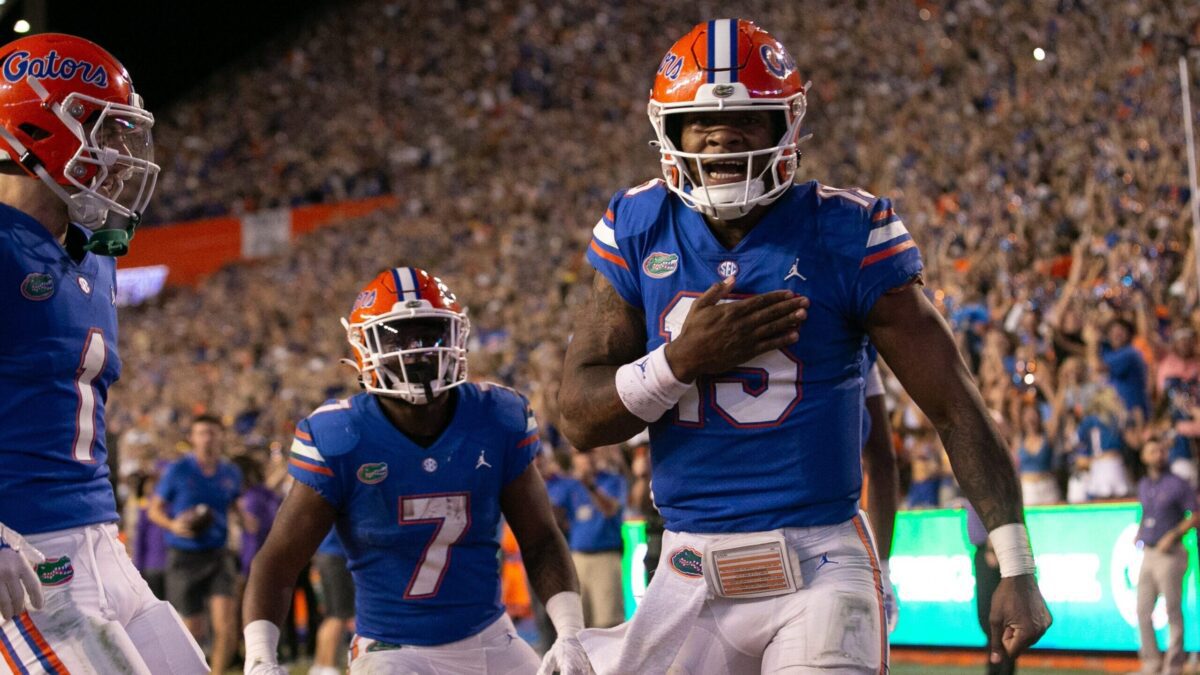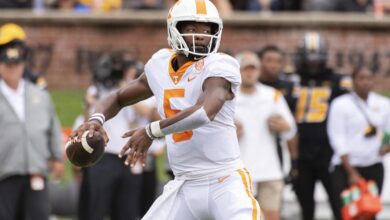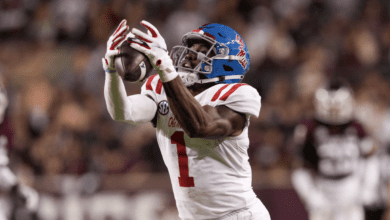College Football: The case for Option football
Ever since the game of football started coaches began to think about how to score points and how to stop the other team from scoring. Formations, strategies, and concepts offensively and defensively arose within the sport. Pop Warner ran the Single Wing offense at Carlisle to use the multi-talented Jim 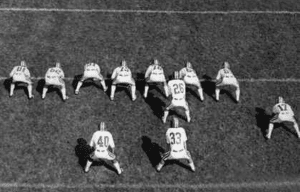 Thorpe. The single wing essentially places the ball in the hands of the best player and gives options to either run or pass. A more recent example would be Baylor using the Single Wing in the Russell Athletic Bowl against North Carolina this year. Ian Boyd does a wonderful job explaining how Baylor used the single wing here. Don Faurot started using the split T expanding on the single wing concepts creating the first “option offense” at Missouri, Emory Bellard used the split T as a base and invented the wishbone for the Texas Longhorns during the 1960’s, Fisher Deberry tinkered with the wishbone creating the a more “flexible” wishbone and established the Flexbone formation.
Thorpe. The single wing essentially places the ball in the hands of the best player and gives options to either run or pass. A more recent example would be Baylor using the Single Wing in the Russell Athletic Bowl against North Carolina this year. Ian Boyd does a wonderful job explaining how Baylor used the single wing here. Don Faurot started using the split T expanding on the single wing concepts creating the first “option offense” at Missouri, Emory Bellard used the split T as a base and invented the wishbone for the Texas Longhorns during the 1960’s, Fisher Deberry tinkered with the wishbone creating the a more “flexible” wishbone and established the Flexbone formation.
The option offense was the foundation of several dynasty’s throughout the sports history: Texas, Oklahoma, Alabama, Nebraska, and Florida all ran the option and won National Championships with it. Bill Yeoman was one of the earliest pioneers of option football in 1963 with his veer offense. The veer is a split-back formation with the offense not blocking two members of the defense and reading what the defenders do. If the defense tackles the lead back then the quarterback pulls the football, continues down the line of scrimmage and reads the next player. From there the quarterback can either pitch the ball to the other tailback or keep the ball and turn up the field. A more detailed explanation of the offense can be found here. The premise of the veer (or any option offense for that matter) is to create an advantage for the offense by having one defender try to cover two players. This idea is very similar to two 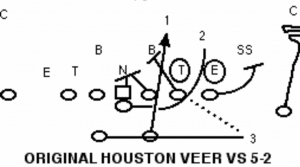 on one fast break in basketball. Yeoman’s offense took college football by storm during the 60’s. The Houston Cougars led the NCAA in total offense three consecutive years during the 1960’s and led the nation in scoring in 1968. Although Yeoman never won a National Champion with Houston he laid the foundation for several dynasties of the 70’s, 80’s and 90’s.
on one fast break in basketball. Yeoman’s offense took college football by storm during the 60’s. The Houston Cougars led the NCAA in total offense three consecutive years during the 1960’s and led the nation in scoring in 1968. Although Yeoman never won a National Champion with Houston he laid the foundation for several dynasties of the 70’s, 80’s and 90’s.
Bear Bryant used the wishbone option offense while at the University of Alabama beginning in 1971. (Prior to 1971 Bryant used a more power based offense. The wishbone revived his career). From 1971 until Bryant’s retirement the Crimson Tide won nine Southeastern conference Championships and three National Titles. Barry Switzer “perfected the bone” in the 1980’s and used more speed with the dive back while at the University of Oklahoma. Switzer Won three national championships during his sixteen-year tenure and finished in the top five in ten of those years. Tom Osborne won three national championships while at Nebraska during the mid-1990’s using the option as a base offense. Osborne ran the option from the “I” formation explained here and seen here.
The flexbone served as the next formation to have the triple option run out of it. Chris Brown of smartfootball.com explains the option from the flexbone offense here. Fisher Deberry first ran the flexbone while at Air Force Academy inspiring other coaches such as Paul Johnson to run the flexbone. Johnson ran the flexbone while at Georgia Southern winning two National Championship’s in five years. Johnson brought the offense to Navy winning forty-five games in six years. He currently runs the offense at Georgia Tech winning two conference titles in 2009 and 2014. Ken Niumatalolo of Navy 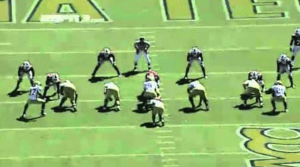 runs the flexbone and won over ten games this year.
runs the flexbone and won over ten games this year.
Both the shotgun and the pistol served as the next formations to use the option. From the early days under Rich Rodriguez and the zone read at West Virginia University to Urban Meyer’s spread option attack at Florida and Ohio State. The option has continued to adapt to the modern game with offensive coordinators using Run/Pass option plays and the forward pass in the triple option. Urban Meyer has had tremendous success running his variation of the shotgun spread winning three national championships (at two different schools) using the offense. With the success of the option-based teams of the past and present my question is why aren’t more teams using this offense?
Let’s look at why teams would not use the option as a base offense:
1. Recruiting. The case against option teams is that schools can not recruit the five-star athletes to run the system. The five-star left tackle is going to go to another school to display pass blocking, the five-star running back is going to go to a school that will utilize him as a feature back. First, the option does not require five-star athletes to be successful. The record-setting Keenan Reynolds of Navy received zero division one scholarship offers. Second, Urban Meyer recruited plenty of talent while coaching at Florida and Ohio State. Paul Johnson has coached two first round picks at wide receiver (Calvin Johnson and Demaryius Thomas) during his tenure. Five receivers are in the NFL from Georgia Tech during the Paul Johnson Era (Johnson only recruits a few receivers a year). Alejandro Villanueva started several games at left tackle for the Pittsburg Steelers this year. Villanueva graduated from West Point 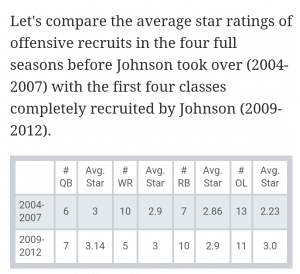 academy.
academy.
2. Third and Long. It is true option offenses do generate short gains from time to time on first and second down, or penalties create third and long situations forcing a team to throw. Looking further, option teams are one of the least penalized teams in the nation. The reality is that third and long situations cause trouble for all offenses, not just option teams.
3. FBS defenses are too fast for the option. Navy won eleven games last year. Georgia Southern beat Florida in 2013 (without completing a pass!), and put up 21 points and over three hundred yards rushing against Alabama in 2011. LSU played Alabama twice that year and only scored 9 points combined in both games.
Reason’s why a team should consider the option:
1. Control the tempo of the game. By running the football and using the option a team controls the clock and limits the possessions of the other team. In a world of up-tempo, spread, no-huddle offenses that routinely score over fifty points a game defenses become more fatigued as the game wears on. Teams that keep opposing offenses on the sideline by dictating tempo create frustration and enable your offense to wear down another team’s defense.
2. Recruiting. While the option offense can deter a five-star athlete from coming to your school. An option offense will help with recruiting. The offensive lineman that are undersized are perfect for an option offense. Quarterbacks that do not possess the arm strength to throw a twenty yard out route from the opposite hash can be option quarterbacks. The best trait of an option quarterback is toughness and smarts. Tim Tebow was not a great quarterback in terms of passing, but put him in an option offense and boom! first round pick and arguably the greatest college quarterback of all time. Georgia Southern led the nation in rushing this year without five-star athletes at quarterback and running back.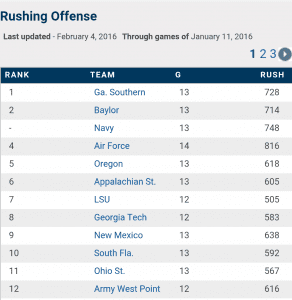
3. Uniqueness. Only a handful of teams in the country run the option making it very difficult to prepare for. Even teams like Navy, Georgia Tech, and Georgia Southern have been running the option for years and nobody has come up with a formula to stop it. Routinely option teams lead the nation in rushing with opposing defenses knowing exactly what is coming and unable to stop it.

- Big Plays. Option teams create big plays. Out of the top five teams in College Football with runs of ten or plus yards last year, three teams ran the option (Georgia Southern, Navy, and Air Force.). Plus twenty yards three teams (Georgia Southern, Air Force, and New Mexico) were in the top five. Plus thirty and forty yards were all option teams. Want to know who led the Nation in yards per pass play last year? not Baylor, not Oregon. All the service academy’s were averaging more than ten yards per pass play.
Several other coaches have won National Championships running the option has the base of their offense. Lou Holtz won a National Championship at Norte Damn with Tony Rice running the option 1988, Bill McCarty at Colorado nearly won back to back National Championships in 1989 and 1990 seasons with Darian Hagan at quarterback (Colorado won the National Championship in 1990). Gene Chizik at Auburn won a National Championship with Cam Newton running a spread option attack. These teams and coaches were not able to sustain championship-level success over the years, but a National Championship is a National Championship.
More team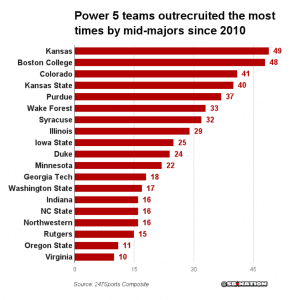 s in College Football should run the option. The SEC has been dominated by Alabama, Georgia, Florida and LSU since 1992. If I was coaching at Vanderbilt or Kentucky I would, at least, consider using the option offense to have a fighting chance against the blue bloods of the SEC. Kansas football has been a disaster over the years on the football field and in the recruiting world. Several FCS teams have surpassed Kansas in the recruiting rankings over the years. Running the option would give Kansas the best option (pun intended) to win.Tim TebowBear Bryant.
s in College Football should run the option. The SEC has been dominated by Alabama, Georgia, Florida and LSU since 1992. If I was coaching at Vanderbilt or Kentucky I would, at least, consider using the option offense to have a fighting chance against the blue bloods of the SEC. Kansas football has been a disaster over the years on the football field and in the recruiting world. Several FCS teams have surpassed Kansas in the recruiting rankings over the years. Running the option would give Kansas the best option (pun intended) to win.Tim TebowBear Bryant.
ATTN Dynasty Commissioners: Do you want to do something cool for your league? How about a 1-hour live show dedicated to YOUR league? Team-by-team breakdowns, rankings, and more. For details and to book a show, visit: GoingFor2.com/plp.
